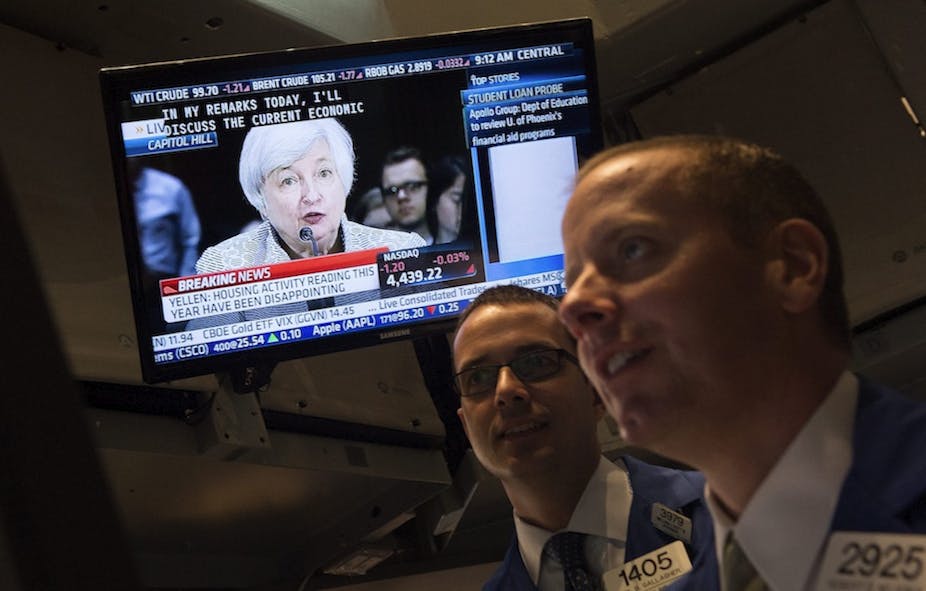There is now keen interest in whether the US Federal Reserve will move to raise its near zero interest rates following two recent pieces of conflicting economic data.
Data on real GDP for the second quarter of 2014 indicate the US economy is growing at an annualised rate of almost 4%. This figure represents a marked turnaround on the negative growth rate for the first quarter of 2014. The average annualised quarterly growth rate for real GDP since the end of the US recession in the second quarter of 2009 is only 2.2%. So the 4% figure represents an above-average outcome.
Some preliminary evidence that the stronger US growth will be maintained into the third quarter of the year can be found in the latest PMI figures for July.
But despite the recent strong growth in real output, the consensus view remains that actual US output is still below its potential output, implying the continued existence of a negative output gap for the US economy (where the output gap is defined as actual output less potential output). The latest Congressional Budget Office estimates for potential output suggest a current output gap of about -4.5%.
Further evidence of a negative US output gap can be found in the unemployment rate, which stood at 6.2% for the month of June. The civilian unemployment rate reached a post-recession peak of 10% in October 2009 and has trended downwards since then.
At 6.2% the unemployment rate is still about 1.8 percentage points above its pre-2008 recession low-point. The current rate also lies above the average rate of 5.3% that was achieved during the 2001 to 2008 expansion.
Both these outcomes raise questions as to whether the Fed will soon end its unconventional monetary stimulus program of quantitative easing, and more significantly begin to increase its interest rate, more properly referred to as the Federal Funds (FF) rate, set just slightly above zero since the end of 2008.
Quantitative easing (QE) is a policy whereby the US Fed purchases longer-term assets - mainly mortgage-backed securities and long-term US Treasuries - with the ultimate objective of reducing long-term interest rates (if the Fed’s purchases bid-up the price of an asset it will reduce its yield). QE began during the GFC and continues today. Recently, the Fed has begun to taper the size of its asset purchases and at its end-July meeting the Federal Open Market Committee (FOMC) reduced the value of monthly asset purchases from $US 35 billion to $US 25 billion.
The other key variable for the Fed’s monetary policy setting is US inflation. The Fed has a stated target rate for inflation of 2% per annum. Standard measures of US inflation are the PCE (personal consumption expenditures) index - which showed year-ended inflation for the month of June at 1.6% - and the CPI (consumer price index) - which showed year-ended inflation for the month of June at 2.1%.
These are headline figures and like most central banks the Fed uses measures of underlying or core inflation as an indicator the general trend in inflation. One widely used measure of US core inflation is the PCE less food and energy, which increased by 1.5% in the year through to June.
Whatever measure is used, the inflation outcomes for the US since the end of the 2008 recession have generally been well below the Fed’s target rate of 2%. To date there has been little pressure from inflation outcomes for the Fed raise the FF rate.
The current unemployment rate and negative output gap are consistent with the view that resource utilisation in the US economy is still below some optimal/normal level. Provided that inflation and its forecasts do not move significantly above the Fed’s 2% target, this will tend to support a continued expansionary stance for monetary policy; with no immediate movement towards raising the FF rate.
A reading of the end-July FOMC Statement suggests that if current tends in US growth and inflation continue, the Fed will move to end its QE program, but may then wait some time to begin raising the FF rate.
Furthermore the process of returning the FF rate to some normal level - a rate approximately equal to the sum of the real interest rate and 2% inflation - is likely to occur via a series of small steps. Current expectations suggest the first increase in the FF rate will be in 2015.
For the Australian economy, the initial effects of rising FF rate are likely to be felt as downward pressure on the value of the Australian dollar.

